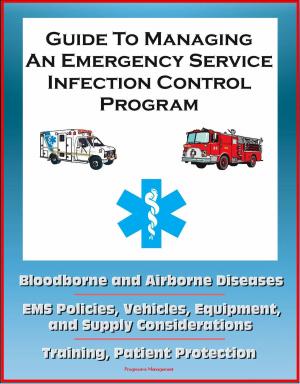21st Century Adult Cancer Sourcebook: Paranasal Sinus and Nasal Cavity Cancer - Clinical Data for Patients, Families, and Physicians
Nonfiction, Health & Well Being, Health, Ailments & Diseases, Cancer| Author: | Progressive Management | ISBN: | 9781465967084 |
| Publisher: | Progressive Management | Publication: | October 19, 2011 |
| Imprint: | Smashwords Edition | Language: | English |
| Author: | Progressive Management |
| ISBN: | 9781465967084 |
| Publisher: | Progressive Management |
| Publication: | October 19, 2011 |
| Imprint: | Smashwords Edition |
| Language: | English |
Authoritative information and practical advice from the nation's cancer experts about paranasal sinus and nasal cavity cancer includes official medical data on signs, symptoms, early detection, diagnostic testing, risk factors and prevention, treatment options, surgery, radiation, drugs, chemotherapy, staging, biology, prognosis, and survival, with a complete glossary of technical medical terms and current references.
Starting with the basics, and advancing to detailed patient-oriented and physician-quality information, this comprehensive in-depth compilation gives empowered patients, families, caregivers, nurses, and physicians the knowledge they need to understand the diagnosis and treatment of paranasal sinus and nasal cavity cancer.
Comprehensive data on clinical trials is included - with information on intervention, sponsor, gender, age group, trial phase, number of enrolled patients, funding source, study type, study design, NCT identification number and other IDs, first received date, start date, completion date, primary completion date, last updated date, last verified date, associated acronym, and outcome measures.
Paranasal sinus and nasal cavity cancer is a disease in which malignant (cancer) cells form in the tissues of the paranasal sinuses and nasal cavity. "Paranasal" means near the nose. The paranasal sinuses are hollow, air-filled spaces in the bones around the nose. The sinuses are lined with cells that make mucus, which keeps the inside of the nose from drying out during breathing.
There are several paranasal sinuses named after the bones that surround them:
The frontal sinuses are in the lower forehead above the nose. The maxillary sinuses are in the cheekbones on either side of the nose. The ethmoid sinuses are beside the upper nose, between the eyes. The sphenoid sinuses are behind the nose, in the center of the skull.
The nose opens into the nasal cavity, which is divided into two nasal passages. Air moves through these passages during breathing. The nasal cavity lies above the bone that forms the roof of the mouth and curves down at the back to join the throat. The area just inside the nostrils is called the nasal vestibule. A small area of special cells in the roof of each nasal passage sends signals to the brain to give the sense of smell.
Together the paranasal sinuses and the nasal cavity filter and warm the air, and make it moist before it goes into the lungs. The movement of air through the sinuses and other parts of the respiratory system help make sounds for talking.
Different types of cells in the paranasal sinus and nasal cavity may become malignant. The most common type of paranasal sinus and nasal cavity cancer is squamous cell carcinoma. This type of cancer forms in the squamous cells (thin, flat cells) lining the inside of the paranasal sinuses and the nasal cavity.
Extensive supplements, with chapters gathered from our Cancer Toolkit series and other reports, cover a broad range of cancer topics useful to cancer patients. This edition includes our exclusive Guide to Leading Medical Websites with updated links to 81 of the best sites for medical information, which let you quickly check for updates from the government and the best commercial portals, news sites, reference/textbook/non-commercial portals, and health organizations. Supplemental coverage includes:
Levels of Evidence for Cancer Treatment Studies
Glossary of Clinical Trial Terms
Clinical Trials Background Information and In-Depth Program
Clinical Trials at NIH
How To Find A Cancer Treatment Trial: A Ten-Step Guide
Taking Part in Cancer Treatment Research Studies
Access to Investigational Drugs
Clinical Trials Conducted by the National Cancer Institute's Center for Cancer Research at the National Institutes of Health Clinical Center
Taking Time: Support for People with Cancer
Facing Forward - Life After Cancer Treatment
Chemotherapy and You
Authoritative information and practical advice from the nation's cancer experts about paranasal sinus and nasal cavity cancer includes official medical data on signs, symptoms, early detection, diagnostic testing, risk factors and prevention, treatment options, surgery, radiation, drugs, chemotherapy, staging, biology, prognosis, and survival, with a complete glossary of technical medical terms and current references.
Starting with the basics, and advancing to detailed patient-oriented and physician-quality information, this comprehensive in-depth compilation gives empowered patients, families, caregivers, nurses, and physicians the knowledge they need to understand the diagnosis and treatment of paranasal sinus and nasal cavity cancer.
Comprehensive data on clinical trials is included - with information on intervention, sponsor, gender, age group, trial phase, number of enrolled patients, funding source, study type, study design, NCT identification number and other IDs, first received date, start date, completion date, primary completion date, last updated date, last verified date, associated acronym, and outcome measures.
Paranasal sinus and nasal cavity cancer is a disease in which malignant (cancer) cells form in the tissues of the paranasal sinuses and nasal cavity. "Paranasal" means near the nose. The paranasal sinuses are hollow, air-filled spaces in the bones around the nose. The sinuses are lined with cells that make mucus, which keeps the inside of the nose from drying out during breathing.
There are several paranasal sinuses named after the bones that surround them:
The frontal sinuses are in the lower forehead above the nose. The maxillary sinuses are in the cheekbones on either side of the nose. The ethmoid sinuses are beside the upper nose, between the eyes. The sphenoid sinuses are behind the nose, in the center of the skull.
The nose opens into the nasal cavity, which is divided into two nasal passages. Air moves through these passages during breathing. The nasal cavity lies above the bone that forms the roof of the mouth and curves down at the back to join the throat. The area just inside the nostrils is called the nasal vestibule. A small area of special cells in the roof of each nasal passage sends signals to the brain to give the sense of smell.
Together the paranasal sinuses and the nasal cavity filter and warm the air, and make it moist before it goes into the lungs. The movement of air through the sinuses and other parts of the respiratory system help make sounds for talking.
Different types of cells in the paranasal sinus and nasal cavity may become malignant. The most common type of paranasal sinus and nasal cavity cancer is squamous cell carcinoma. This type of cancer forms in the squamous cells (thin, flat cells) lining the inside of the paranasal sinuses and the nasal cavity.
Extensive supplements, with chapters gathered from our Cancer Toolkit series and other reports, cover a broad range of cancer topics useful to cancer patients. This edition includes our exclusive Guide to Leading Medical Websites with updated links to 81 of the best sites for medical information, which let you quickly check for updates from the government and the best commercial portals, news sites, reference/textbook/non-commercial portals, and health organizations. Supplemental coverage includes:
Levels of Evidence for Cancer Treatment Studies
Glossary of Clinical Trial Terms
Clinical Trials Background Information and In-Depth Program
Clinical Trials at NIH
How To Find A Cancer Treatment Trial: A Ten-Step Guide
Taking Part in Cancer Treatment Research Studies
Access to Investigational Drugs
Clinical Trials Conducted by the National Cancer Institute's Center for Cancer Research at the National Institutes of Health Clinical Center
Taking Time: Support for People with Cancer
Facing Forward - Life After Cancer Treatment
Chemotherapy and You















